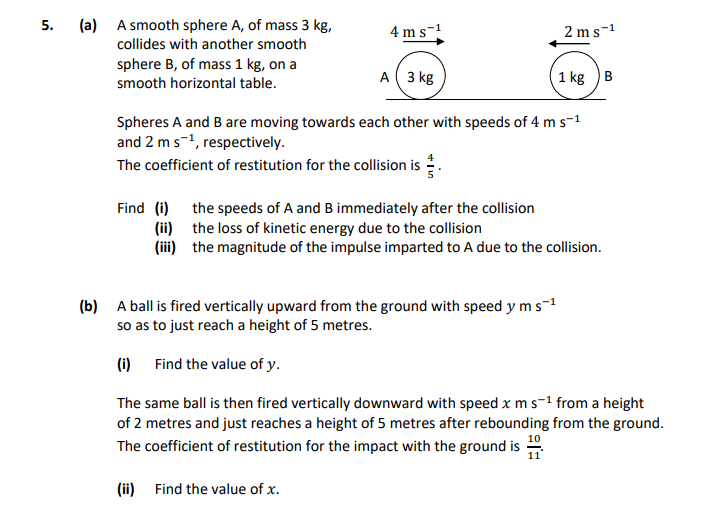Photo AI
A smooth sphere A, of mass 3 kg, collides with another smooth sphere B, of mass 1 kg, on a smooth horizontal table - Leaving Cert Applied Maths - Question 5 - 2018
Question 5

A smooth sphere A, of mass 3 kg, collides with another smooth sphere B, of mass 1 kg, on a smooth horizontal table. Spheres A and B are moving towards each other wi... show full transcript
Worked Solution & Example Answer:A smooth sphere A, of mass 3 kg, collides with another smooth sphere B, of mass 1 kg, on a smooth horizontal table - Leaving Cert Applied Maths - Question 5 - 2018
Step 1
Find (i) the speeds of A and B immediately after the collision
Answer
To find the velocities immediately after the collision, we can use the principle of conservation of momentum (PCM) and the formula that relates velocities with the coefficient of restitution (e).
Using momentum conservation: [ 3(4) + 1(-2) = 3v_A + v_B ] [ 12 - 2 = 3v_A + v_B ] [ 10 = 3v_A + v_B \quad (1) ]
From the coefficient of restitution: [ e = \frac{v_B - v_A}{u_A - u_B} ] Substituting in the known values: [ \frac{4}{5} = \frac{v_B - v_A}{4 + 2} ] [ \frac{4}{5} = \frac{v_B - v_A}{6} ] [ 4 \cdot 6 = 5(v_B - v_A) ] [ 24 = 5(v_B - v_A) ] [ v_B - v_A = \frac{24}{5} \quad (2) ]
Solving equations (1) and (2) simultaneously: From (2), we derive that: v_B = v_A + \frac{24}{5}. Substituting into (1): [ 10 = 3v_A + (v_A + \frac{24}{5}) ] [ 10 = 4v_A + \frac{24}{5} ] Multiplying through by 5 to eliminate the fraction: [ 50 = 20v_A + 24 ] [ 26 = 20v_A ] [ v_A = 1.3 , m s^{-1} ] Substituting back to find ( v_B ): [ v_B = 1.3 + \frac{24}{5} = 6.1 , m s^{-1} ]
Step 2
Find (ii) the loss of kinetic energy due to the collision
Answer
To find the kinetic energy before and after the collision:
The initial kinetic energies: [ KE_A = \frac{1}{2} m_A v_{A_{initial}}^2 = \frac{1}{2} (3)(4^2) = 24 ] [ KE_B = \frac{1}{2} m_B v_{B_{initial}}^2 = \frac{1}{2} (1)(2^2) = 2 ]
Total initial kinetic energy: [ KE_{initial} = KE_A + KE_B = 24 + 2 = 26 ]
The final kinetic energies: [ KE_{A_{final}} = \frac{1}{2} m_A v_{A_{final}}^2 = \frac{1}{2} (3)(1.3^2) = 2.54 ] [ KE_{B_{final}} = \frac{1}{2} m_B v_{B_{final}}^2 = \frac{1}{2} (1)(6.1^2) = 18.61 ]
Total final kinetic energy: [ KE_{final} = KE_{A_{final}} + KE_{B_{final}} = 2.54 + 18.61 = 21.15 ]
The loss of kinetic energy: [ Loss = KE_{initial} - KE_{final} = 26 - 21.15 = 4.85 ]
Step 3
Find (iii) the magnitude of the impulse imparted to A due to the collision
Answer
Impulse can be calculated using the change in momentum: [ Impulse = \Delta p = m_A (v_{A_{final}} - v_{A_{initial}}) ] [ Impulse = 3(1.3 - 4) = 3 \cdot -2.7 = -8.1 ] Thus, the magnitude of the impulse: [ |Impulse| = 8.1 , N s ]
Step 4
Step 5
